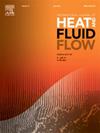化学反应和辐射对热物理特性可变的参与式固气流的影响
IF 2.6
3区 工程技术
Q2 ENGINEERING, MECHANICAL
International Journal of Heat and Fluid Flow
Pub Date : 2024-10-14
DOI:10.1016/j.ijheatfluidflow.2024.109596
引用次数: 0
摘要
本文研究了辐射传热和化学反应对参与气固流动的综合影响。利用相似性转换方法,建立了一个半解析模型来研究与温度相关的热物理性质的影响。结果表明,辐射对 CuCl2 水解反应过程中的边界层流动有很大影响。较大的辐射参数和化学反应的存在导致边界层厚度增加。存在辐射时,化学反应对热边界层的影响减小。对浓度分布的研究表明,辐射、固体质量分数和不同的热物理性质共同影响了表面附近的物种浓度分布,表明传质和反应速率增强。不同热物理性质和热辐射的共同影响导致表面附近的化学物种浓度降低。这是由于传质增强、反应速率增加或流体性质随温度变化而变化,导致物种更快地扩散到远离边界的地方。这些结果为预测 CuCl2 水解反应过程中参与固气流动的传热提供了有用的新见解。本文章由计算机程序翻译,如有差异,请以英文原文为准。
Effects of chemical reactions and radiation on a participating solid-gas flow with variable thermophysical properties
This paper investigates the combined effects of radiative heat transfer and chemical reactions on a participating gas–solid flow. A semi-analytical model is developed to investigate the effects of temperature dependent thermophysical properties using a similarity transformation method. It is observed that radiation significantly influences the boundary layer flow during the CuCl2 hydrolysis reaction. Larger radiation parameters and the presence of the chemical reaction led to an increase in the boundary layer thickness. Effects of the chemical reaction on the thermal boundary layer decrease in the presence of radiation. A study of the concentration profile shows that radiation, solid mass fraction, and variable thermophysical properties collectively influence the species concentration distribution near the surface, suggesting enhanced mass transfer and reaction rates. The combined influence of varying thermophysical properties and thermal radiation leads to a reduction in the chemical species concentration near the surface. This occurs from enhanced mass transfer, an increase in the reaction rate, or changes in fluid properties with temperature causing faster diffusion of species away from the boundary. The results offer useful new insights in predicting heat transfer in participating solid–gas flows during the CuCl2 hydrolysis reaction.
求助全文
通过发布文献求助,成功后即可免费获取论文全文。
去求助
来源期刊

International Journal of Heat and Fluid Flow
工程技术-工程:机械
CiteScore
5.00
自引率
7.70%
发文量
131
审稿时长
33 days
期刊介绍:
The International Journal of Heat and Fluid Flow welcomes high-quality original contributions on experimental, computational, and physical aspects of convective heat transfer and fluid dynamics relevant to engineering or the environment, including multiphase and microscale flows.
Papers reporting the application of these disciplines to design and development, with emphasis on new technological fields, are also welcomed. Some of these new fields include microscale electronic and mechanical systems; medical and biological systems; and thermal and flow control in both the internal and external environment.
 求助内容:
求助内容: 应助结果提醒方式:
应助结果提醒方式:


